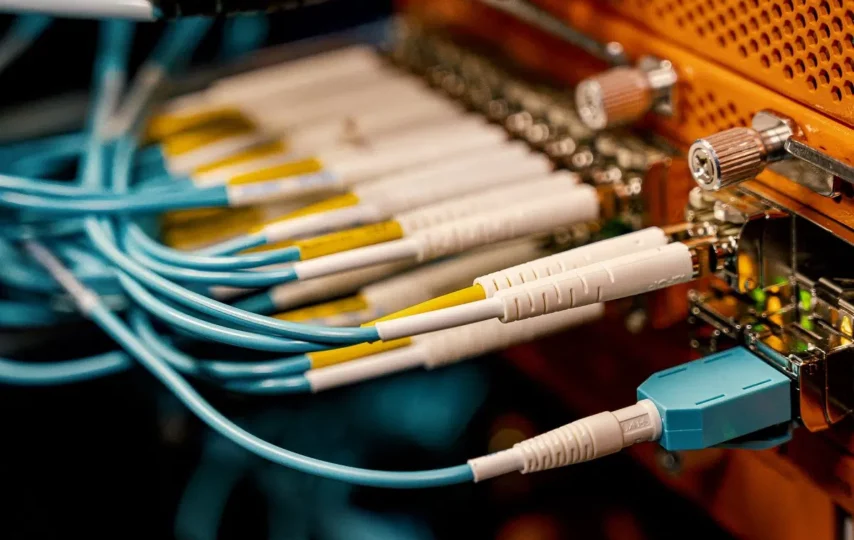Fiber optic cables are available in two major types – single-mode fiber (SMF) and multimode fiber (MMF). While single-mode fiber is usually used for long-distance data transmission, multimode optical fiber is more suitable for short-distance transmissions, like computer network linking. Although both the options- multimode and single-mode fiber optic cables employ the same standard principles, each has diverse advantages and disadvantages. This makes them suitable for some particular situations. Thus, it is crucial to know when to use which cable while configuring your new fiber-optic network. Let us know more about single-mode fiber optic cable before we dive into the installation process.
What Is Single-Mode Fiber Optic Cable?
Single-mode optical fiber cables are designed to carry a single beam of light that is used as the transverse mode. These cables employ lasers that operate at 1310 to 1550 nm wavelengths as a light source. The core diameter is just 8.5μm, much smaller than multimode cables. As mentioned earlier, single-mode fiber optic cables are typically used in long-distance telecommunication applications. Since single-core cables project light in various patterns, these can also be used for ornamental illumination.
Benefits of Installing Single-Mode Fiber Optic Cable
The following are the many advantages of installing single-mode fiber optic cable:
· Single-mode fiber optic cables can send data at speeds of up to 10Gb when the distances are greater, such as thousands of kilometers
· These cables and connectors are generally a little affordable as compared to multimode
· Single-mode fiber optic transmissions are much faster as compared to multimode over longer distances. This is because they need fewer switches or routers mid-span
· These are capable of transmitting data at up to 40Gb over hundreds of kilometers with little to no integrity loss
· Single-mode fiber optic cables have virtually unlimited bandwidth capacity
· DWDM technology lets the C-Band (1530 to 1565 nm wavelengths) be divided into 192 discreet channels per fiber pair. Each of these channels is capable of carrying 100 Gbps, which translates to 19.2 Tbps.
Similarly, the multimode cable also has a wide range of benefits. Regardless of which fiber optic cable type you use, ensuring a sound fiber optic cable installation is essential. This will help you avail of all these benefits mentioned above.
Challenges Faced During the Installation Process of Single-Mode Fiber Optic Cable
Fiber cable installation can be categorized into four types: direct burial installation, aerial fiber installation, household fiber cable installation, and underground duct installation. There can be a bunch of challenges faced in the deployment of fiber cable. Let us discuss the following:
Technical Issues and Challenges
Fiber cable installation using the direct burial installation method in a developing country can pose numerous technical issues. Usually, underground fiber optics cable is laid along the highways and the city roads. However, if any building is unauthorized, planning the route and then adhering to the planned routes can become quite challenging.
Management After Fiber Deployment
Post-deployment management is generally based on fundamental engineering principles and objectives that ensure proper operation, maintenance, storage, repair, and restoration of fiber infrastructure without excessive expenditure. Good management is vital for fiber optics networks which will, in turn, protect them from damages, such as bends, cuts, and any other form of activity that can prove to be destructible for the cable. Thus, effective management of this infrastructure is imperative for MNOs as well as end users.
Adherence To Best Practices for Fiber Optic Cable Deployment and Management
Until the late 1990s, there was no installation standard for optical cables. However, things have changed with time. Different countries adhere to different guidelines for fiber optic cable installation. In India, Fiber Optic Technical Information Cabling states that the installation method includes processes like survey, clearing, trench drilling, tunnel drilling, permanent lubrication – high polyethylene pipes (PLB HDPE), Hume reinforced concrete pipes, and steel pipes (GI), marking, filling rear, underground cable installation, construction of service holes, cutting, crossing. There are also requirements for the acceptance test of the underground fiber optic cabling system. Adhering to all these practices can become challenging.
Single-mode fiber optic cable offers various advantages, and to benefit from all of them, the installation process should be correctly done. We hope this information will help you know the various challenges in this process and find ways to overcome them.







